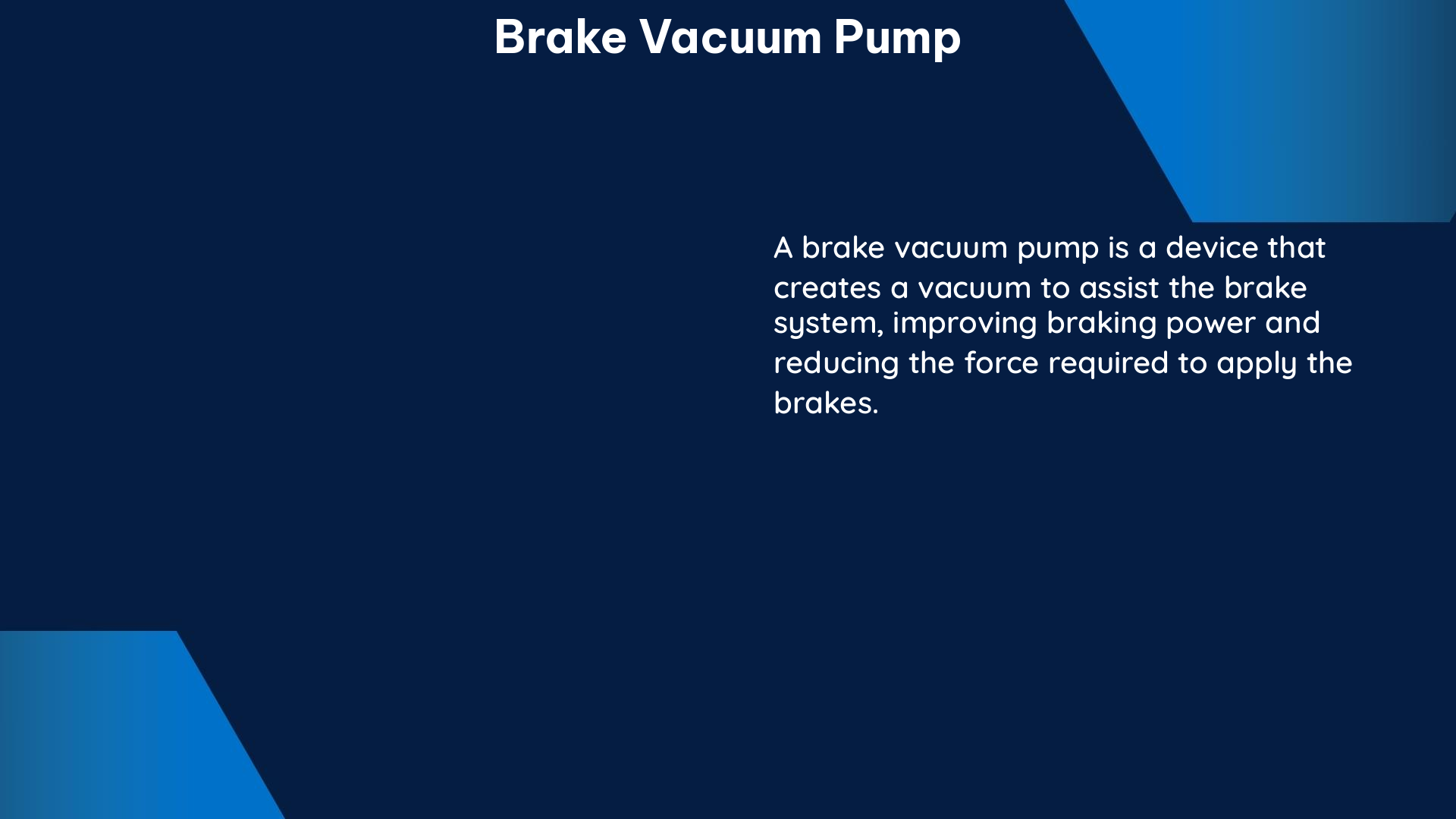The brake vacuum pump is a critical component in the braking system of many modern vehicles, responsible for generating the necessary vacuum to assist the brake booster and ensure effective braking. This comprehensive guide delves into the technical specifications, measurements, and advanced hands-on details of brake vacuum pumps, providing a valuable resource for both DIY enthusiasts and professional technicians.
Technical Specifications of Brake Vacuum Pumps
Brake vacuum pumps are positive displacement pumps that operate based on the rotary vane compressor principle. They consist of a rotor that is off-center to the pump chamber, with one or more movable slides that are pressed against the inner wall of the pump chamber by centrifugal force. This design allows the pump to displace air from the suction side to the pressure side, generating a vacuum that causes air to be sucked in by the brake booster through the vacuum pump via the pneumatic brake line system.
The size and specifications of the brake vacuum pump can vary depending on the vehicle and engine type. For example, the HELLA UP28 vacuum pump used in the Opel Cascada 1.4i 16V Turbo has the following technical specifications:
| Specification | Value |
|---|---|
| Pump Type | Rotary Vane |
| Voltage | 12V DC |
| Power Consumption | 120W |
| Maximum Vacuum | -0.8 bar |
| Pressure Sensor | Yes |
| Designed for Turbocharger | Yes |
| Designed for Stop-Start System | Yes |
These technical details are crucial in understanding the pump’s capabilities and ensuring compatibility with the specific vehicle and engine configuration.
Measurements and Data Points

The brake vacuum pump’s performance can be evaluated through various measurements and data points. One of the primary ways to test and diagnose the pump is by using a diagnostic unit, which can display the pressure gradient in the brake booster using the “Parameter” function.
A simple functional check of the electric vacuum pump can also be performed in the vehicle by listening for the pump to run up temporarily to increase or balance out the required vacuum in the brake booster. This can provide a quick indication of the pump’s operation, but more comprehensive testing is recommended for a thorough assessment.
Additionally, the brake vacuum pump’s performance can be affected by the condition of the pneumatic lines, valves, and the brake booster itself. It is essential to check for any particles or contamination in these components, as they can lead to pump damage and reduced efficiency.
Advanced Hands-On Details
When diagnosing a faulty electric vacuum pump, it is crucial to start with a visual inspection of the individual system components. This includes checking the pneumatic and electric connections of the vacuum pump, as well as the condition of all other vacuum lines leading to the brake booster.
After the initial visual inspection, control unit diagnostics can be performed using a suitable diagnostic unit. This tool can exchange error memories and warn the driver about any system errors through the instrument cluster display. By accessing this diagnostic data, technicians can pinpoint the root cause of the issue and develop an appropriate repair plan.
DIY for Brake Vacuum Pump
While it is possible for vehicle owners to perform a simple functional check of the electric vacuum pump, more complex diagnostics and repairs should be left to professional technicians. Attempting to repair the brake vacuum pump without the necessary tools and expertise can lead to further damage or safety concerns.
It is important to note that the brake vacuum pump is a critical component in the braking system, and any improper repairs or modifications can have serious consequences. Proper diagnosis and repair should be carried out by qualified mechanics who have the necessary knowledge, tools, and experience to ensure the safe and effective operation of the brake vacuum pump.
Conclusion
The brake vacuum pump is a vital component in the braking system of many modern vehicles, and understanding its technical specifications, measurements, and advanced hands-on details is crucial for maintaining and troubleshooting this critical system. By following the guidelines and recommendations outlined in this comprehensive guide, both DIY enthusiasts and professional technicians can ensure the proper diagnosis, repair, and maintenance of brake vacuum pumps, ultimately contributing to the overall safety and performance of the vehicle.
References:
- HELLA Technical Information: Testing an Electric Vacuum Pump
- California Air Resources Board: Brake and Tire Wear Emissions
- JK-Forum: Brake Vacuum Booster Pump Failed

The lambdageeks.com Core SME Team is a group of experienced subject matter experts from diverse scientific and technical fields including Physics, Chemistry, Technology,Electronics & Electrical Engineering, Automotive, Mechanical Engineering. Our team collaborates to create high-quality, well-researched articles on a wide range of science and technology topics for the lambdageeks.com website.
All Our Senior SME are having more than 7 Years of experience in the respective fields . They are either Working Industry Professionals or assocaited With different Universities. Refer Our Authors Page to get to know About our Core SMEs.